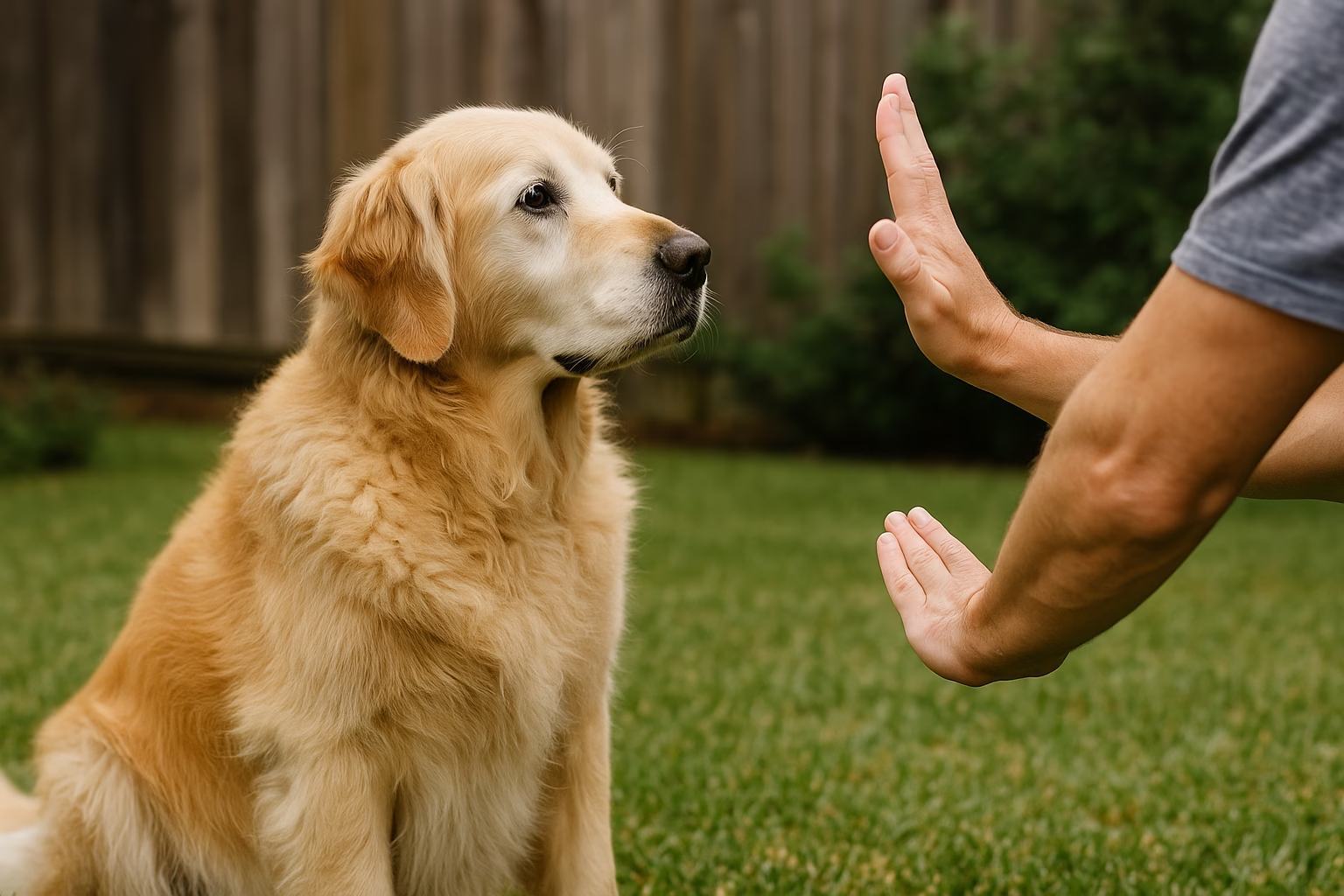Teaching Hand Signals to Senior Golden Retrievers is my practical guide to help older goldens with hearing and mobility changes. I explain why visual cues work, share quick facts on vision, hearing, and aging, and give a simple step‑by‑step plan. Short, consistent sessions and positive reinforcement with treats and praise make learning fun. I include a three‑signal starter set, low‑impact gestures for arthritic dogs, slow large motions that are easy to see, and steps I use for deaf elderly goldens with touch, lights, and hand signals. I cover tools and safety, enrichment games to boost our bond, troubleshooting tips, and when to recommend a vet or certified trainer.
Key Takeaway
- I use slow, clear hand signals my senior Golden can see.
- I give a treat with each sign to help my Golden learn.
- I do short, calm practice sessions every day.
- I stand where my Golden can see my hands and face.
- I praise and repeat gently if my Golden seems confused.
Why Teaching Hand Signals to Senior Golden Retrievers helps with hearing and mobility changes
I started Teaching Hand Signals to Senior Golden Retrievers when my old Buddy began to miss words. He would look blank when I called him from the yard, but he still watched my hands. Hand signals gave him a clear way to understand me without raising my voice. They also help with mobility: a clear visual cue can prompt a small step or a full move without me having to walk right up to him. Short, gentle gestures let me guide him from a safe distance so he can stay independent longer.
Using signals keeps his mind active—an important part of long‑term care described in ways to keep senior goldens mentally engaged. Training that uses sight and reward gives him a task to think about, which fights boredom and keeps habits sharp. Small wins—signal, response, treat—build confidence.
- Start simple: pick 3 signals (sit, come, wait); pair each with touch and a treat; practice 3–5 minutes twice a day; fade voice after the dog reliably responds visually. For a gentle, patient approach to older dogs, see gentle training methods for senior goldens.
How hand signals for senior golden retrievers support dogs with mild hearing loss
Hand signals act as a bridge when hearing fades. Pair sound and sight at first (say the command, show the signal, reward quickly), then gradually lower the voice until the visual cue alone works. This gradual change keeps the dog confident and reduces confusion, especially on windy days or at a distance. For specific strategies on managing hearing loss, consult advice for hearing loss in senior goldens.
The science behind visual cues training older golden retrievers and attention
Older dogs still learn but need simpler patterns and more repetition. Visual cues tap into a dog’s natural ability to read body language. Clear, consistent gestures are easier for an aging brain to process than fast speech. Short sessions and frequent rewards help memory and focus. Each successful cue activates the reward system, encouraging more tries without tiring joints. For more on habit formation and consistent routines, read how habits form in golden retrievers.
Quick facts on vision, hearing, and aging in golden retrievers
Golden retrievers often show gradual decline in hearing and vision after age seven to nine. Eyes may cloud, pupils react slower, and ears can miss high pitches. Watch for changes in startle response, bumping into furniture, or not coming when called. Gentle visual cues, brighter contrast, and slower movements help a lot. For signs of vision change, see vision problems to watch for.
| Sense | Typical change with age | What to watch for | Simple signal tip |
|---|---|---|---|
| Hearing | Loss of high pitches; patchy awareness | Not responding to name or whistle | Use big arm sweep for “come” — see hearing loss strategies |
| Vision | Clouding, slower focus | Hesitation on stairs, bumping into objects | Use high‑contrast hand shapes near face — see vision tips |
| Mobility | Stiffness, slower gait | Reluctance to jump or climb | Signal “walk” with low, steady motion and lure steps — related to gentle daily activities |
Basic step-by-step plan for Teaching Hand Signals to Senior Golden Retrievers
I started Teaching Hand Signals to Senior Golden Retrievers when Buddy began losing some hearing. The plan I use is simple and kind: pick clear signals, match each to a small reward, and practice in short bursts. Steady progress, not speed, is the goal. For a full training roadmap tailored to older goldens, see how to train your senior golden.
- Choose 2–3 signals and the exact hand shape for each.
- Use high‑value treats and low distractions.
- Work 3–5 minutes, 2–4 times a day.
- Reward immediately when the dog responds.
- Gradually fade treats into praise and touch.
Pay attention to energy and joints. Teach from a sitting or comfy spot if needed. Keep hand shapes large and steady, use soft light to avoid shadow or glare, and track small wins. If progress stalls, add mild distractions gradually or go back a step. For troubleshooting and common behavioral shifts, check behavioral changes in aging goldens.
Short, consistent sessions I use to teach hand signal commands for older dogs
Two to five minutes works best. Repeat the same move three to five times per session—enough to build memory without boring him. Stop if he nuzzles or yawns. Consistency beats marathon practice. Building this into daily life links well with daily routines senior goldens appreciate.
My positive reinforcement routine with treats and praise
Pick soft, small treats so older dogs don’t fuss chewing. Give the treat right when the sign is correct—timing matters. After several successful reps with treats, switch to a happy praise and a gentle rub, mixing treats occasionally so he stays eager. Never scold for a slow response; that creates anxiety and slows learning. Positive reinforcement is especially effective with older dogs—learn more at why positive reinforcement works best.
A simple three-signal starter set for older goldens
I begin with Sit, Come, and Target. These cover safety and daily life and are easy for eyes that still track movement.
| Signal | Hand Motion | Quick Tip |
|---|---|---|
| Sit | Flat palm moves down over the head | Pause until rear lowers, reward fast |
| Come | Sweep palm toward chest | Step back a little to invite movement |
| Target (touch) | Index finger or open palm held out | Use on walks to guide around obstacles — pairs well with behavior training techniques |
Adapting signals for arthritic and low‑mobility dogs
When arthritis set in, the work became less about speed and more about clarity. Slow down, widen motions, and keep everything at eye level so the dog doesn’t have to crane his neck. Repeat the same slow signal three times rather than one quick flash. Pair the hand cue with a soft voice and a tasty treat so he understands without straining. For ideas on creating comfortable spaces and reducing strain, see creating comfort for senior goldens.
Practical changes I make for arthritic golden retrievers
- Start close and slow: stand near, use one clear motion, repeat up to three times.
- Lower the signal: bring gestures to chest or hip height.
- Use big, open shapes: wide palm, sweeping arm, slow point.
- Pair with voice and treat: one soft word and a reward to reinforce.
- Short sessions: 3–5 minutes, a few times a day to avoid fatigue.
For daily care adjustments and routines that support mobility, review simple daily care routines.
Best hand gestures for senior dogs that reduce strain and encourage movement
| Gesture | How I do it | Why it helps |
|---|---|---|
| Open palm sweep forward | Arm out, palm up, sweep slowly toward chest | Encourages forward step without neck twist |
| Flat hand lift at chest | Raise flat hand slowly in front of chest, hold 2–3 seconds | Signals sit without forcing downward pressure |
| Slow downward sweep | Sweep hand down in a wide arc toward the floor | Guides slow lowering to lie down, reduces sudden drops |
| Point-to-ground with palm | Point slowly to a spot on the floor, palm visible | Marks a target for gentle movement, good for short walks |
Use big, theatrical gestures—slow waves or wide arcs—so they can be read with minimal effort. For ideas to keep daily life enriching, try gentle daily activities that support well‑being.
Training deaf elderly golden retrievers: visual cues and combined signals
When Buddy went deaf gradually, sound-based cues stopped working. Visual cues, lights, and gentle touch became our language. Start with big, slow gestures in the same spot every day. Consistency and short sessions help the dog connect motion to outcome. Use lamps in dim rooms and keep small routines—same chair, same placemat—to make signals reliable. If hearing loss is advanced, follow the strategies in a guide to coping with deafness.
Steps I follow when training deaf elderly golden retrievers with only visual cues
- Start with one command (sit). Show the hand signal, wait, then gently guide him into position. Reward immediately with a treat or touch.
- Repeat 5–10 times, then stop before he gets bored.
- Add distance slowly—one step back at a time.
- Introduce the next command only after the first is reliable.
- Use the same signal, same motion, same reward every time.
How I combine touch, lights, and hand signals
| Signal | Visual cue | Touch or light cue |
|---|---|---|
| Sit | Flat palm facing down | Gentle pressure on hindquarters |
| Come | Sweeping arm toward chest | Flash short light to get gaze — see creating calm environments |
| Stay | Open hand, palm out | Light tap and step back |
| Down | Hand lowering slowly | Gentle guidance on chest |
Practice combos in familiar places first, then slowly add new spots. Use a small lamp in confusing environments until he catches on.
Tools and safety tips for non‑hearing senior goldens
Use soft harnesses, non‑slip rugs, a bright but gentle flashlight, and high‑value treats. Avoid sudden flashing lights that could startle him. Keep stairways clear and add ramps if needed. Always check with your vet about vision and mobility issues before increasing activity. For suitable toys and aids, see appropriate toys for senior goldens.
Enrichment and bonding: improve quality of life with hand signals
Hand signals give older dogs a way to keep working their brain without tiring joints. Short sessions—five minutes, two or three times a day—keep them alert and calm. Signals reduce confusion, lower stress on ears, and offer gentle movement that keeps joints engaged. Use signals for simple choices—sit, come, down, paw—and routines like “walk time” or “treat.”
For structured mental work, check mental enrichment activities for senior goldens, and read about building stronger bonds through consistent interaction.
| Hand Signal | Action | Why it helps |
|---|---|---|
| Palm up, lift finger | Sit | Easy to see from standing; low joint strain |
| Wave forward | Come | Clear directional cue for short distances |
| Flat hand down | Down/Rest | Encourages calm, reduces pacing |
| Open hand toward paw | Paw/Touch | Gentle interaction that builds confidence |
Fun games and daily routines
Turn simple games into training: slow indoor fetch with a soft toy and a wave forward signal, or a scent trail that ends with a visual cue to sit for a treat. For meals and walks, add tiny signals so he makes a choice and gets praise. Examples:
- Hand‑signal treasure hunt: hide a few treats in easy spots, show the search signal, guide with visual cues, reward with calm praise. See more activity ideas in everyday joys with senior goldens and mental enrichment ideas.
How positive reinforcement hand signals strengthen our bond
Pairing a signal with a treat, touch, and a happy tone builds trust. Positive reinforcement turns training into a warm conversation. Using the same simple signals every day made life calmer; Buddy started asking for favorite activities with a tail wag and an expectant glance when I lifted my hand. For more on the emotional side, see how signals deepen your bond.
Troubleshooting common issues and when to seek professional help
Older dogs can freeze or look confused; many behavior problems are medical, sensory, or fatigue‑related. Slow down, watch body language, and adjust.
Checklist before calling a pro:
- Check for pain or stiffness by watching walks and how he lies down.
- Try clearer, slower signals and shorter sessions for three days.
- Add scent or touch cues if vision or hearing seems weaker.
- If no improvement or if things worsen, call the vet or a certified trainer.
For guidance on which behavior changes are typical and which need attention, consult behavioral changes in aging goldens. If you need professional training help, consider approaches in top behavior training techniques.
How I handle confusion, fear, or plateaus
When confused, go back to basics: 2–3 minute sessions, show the same signal three times, and reward every try—even small movement. For fear, avoid the trigger, use calm praise, pair the signal with a soft treat and petting, and let the dog set the pace. If stuck in fear, slow everything and be patient.
When to call a vet or certified trainer
Call the vet for sudden or dramatic changes—bumping into furniture, getting lost, head tilt, or clear pain. These can indicate ear infections, vision loss, cognitive decline, or joint pain. A certified trainer with senior‑dog experience is helpful for steady but troubling behaviors (aggression, refusal to follow cues) or to teach mobility‑aware handling and adapted signals. If a trainer and vet coordinate, results come faster and with less stress.
Warning signs that need medical or professional assessment
| Warning sign | Possible cause | Immediate action |
|---|---|---|
| Bumping into things | Vision loss or disorientation | Vet exam; reduce obstacles at home — see vision guidance |
| Sudden confusion or getting lost | Cognitive decline or neurological issue | Vet visit; note onset |
| Limping or stiffness | Arthritis or injury | Vet pain check; shorter walks; gentle handling — see creating comfort strategies |
| New aggression or fear | Pain, discomfort, or sensory changes | Stop triggers; consult vet and trainer |
Additional tips for Teaching Hand Signals to Senior Golden Retrievers
- Keep a simple signal log: note the cue, the response, location, and reward used. Small records reveal patterns.
- Use contrast: darker glove or tape on your hand helps if their vision is cloudy.
- Keep one side consistent: always present signals from the same side while teaching.
- Be patient with setbacks: sickness, medication changes, or bad nights affect learning.
For ongoing routine ideas and maintaining calm, explore creating a healthy routine and creating calm environments.
Conclusion
I wrote this guide because I wanted a gentle, practical way to keep my senior Golden connected as his hearing and mobility changed. Hand signals became our second language—slow, clear gestures that cut through confusion and kept life calm. Short, consistent sessions, positive reinforcement, and a steady routine were the keys. Small wins mattered more than grand strides.
If your dog has arthritis or fading senses, adapt the signals: lower the motion, widen the sweep, and use touch or a soft light for extra cues. Start with a simple three‑signal set, reward immediately, and watch body language more than obedience. When something feels off, trust your instincts and check with a vet or a certified trainer—some problems are medical, not behavioral.
Training older dogs is part patience, part creativity, and all heart. I kept things short, kind, and predictable, and it paid off in wagging tails and quieter days. For more guides and practical articles on senior golden care, see gentle methods and patience for training senior goldens.

Rafael Souza is a digital marketing strategist and lifelong dog enthusiast. Passionate about Golden Retrievers, he shares practical, research-based tips to help owners provide healthier and happier lives for their furry companions.





